The human body requires adequate oxygen concentration to function properly. A healthy body regulates blood oxygen concentrations via the respiratory system. If a patient’s values are too low or too high, it means something has gone wrong with their breathing. This makes reliable measurements of blood oxygen concentrations especially crucial in caring for patients with respiratory problems who are receiving artificial respiration. At present, the most common method of determining hypoxia — when oxygen levels are too low — is a non-invasive one known as pulse oximetry. A small device called a pulse oximeter is clipped to the patient’s finger to display the O2 concentration in the blood. The issue is that the measurements are not accurate. The only way to get more reliable values is to take a sample of arterial blood and then perform a blood gas analysis, which is an unpleasant and sometimes even painful procedure for the patient. Fraunhofer IPM in Freiburg has developed a noninvasive sensor in an effort to enable painless and yet ultra-accurate measurements in the future. Attached to a breathing mask or ventilator tube, it will surpass the current state of technological advancement in terms of accuracy and cost-effectiveness, replacing existing measurement systems.
“Our sensor measures the oxygen content in people’s breath, which allows us to extrapolate to the blood oxygen concentration,” says Mahmoud El-Safoury, project manager at Fraunhofer IPM. “We use the quenching effect for the O2 sensor we developed.” In this method, a fluorescent coating deposited on an aluminum substrate is exposed to short-wave light, which causes the layer to glow. The light emitted is longer in wavelength than the light that is “exciting” the fluorescent substance, which means it is lower in energy. Then, when oxygen molecules come into contact with the coating, the fluorescent light is markedly diminished. The weaker the light, the higher the oxygen concentration. “Our measuring method is so fast and precise that we can measure oxygen concentrations down to the level of individual breaths,” El-Safoury explains.
Quenching: A new method in medical engineering
To develop the fluorophore coating, the researchers at Fraunhofer IPM studied different fluorescent chemical compounds with optimum characteristics in terms of response time, signal intensity, and long-term stability. They ended up choosing a type of pyrene. To create the layer, the fluorophore had to be embedded in a suitable matrix, which is a complex process. “Quenching is already used to determine the concentration of dissolved oxygen in liquids in sectors such as the food industry and at water and wastewater treatment plants, for example. It’s a novel method in medical engineering, though,” says Dr. Benedikt Bierer, group manager at Fraunhofer IPM. Another advantage of this principle is that the sensor enables continuous measuring of oxygen concentrations throughout an entire day. Invasive arterial blood sampling, by contrast, is performed only once a day or, for critical patients in intensive care, several times daily. This means that there is no data on any changes in the patient's health condition for the time in between.
The miniature sensor measures just 26 mm in diameter. It can be attached to any T-connector, a standardized adapter that is then connected to a breathing mask or ventilation tube. The sensor head with integrated optics includes an LED light source, a detector, two sapphire lenses, and a sample with the fluorophore coating, which hospital staff need to change regularly. The sample has to be kept in sterile and gas-tight storage, just like bandages.
The researchers are currently investigating whether there are cross-sensitivities to other gases such as CO2 that could impair the sensor’s oxygen measuring signal. The influence of parameters such as humidity and temperature on the signal is also being studied, along with the long-term stability of the system and the various sterile storage options. “There is a wide range of potential future applications — the tiny sensor can be used by paramedics, in hospital settings, and even at home by patients with lung disease,” El-Safoury says.
